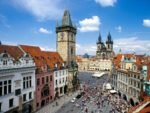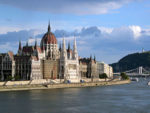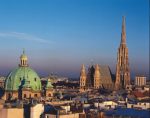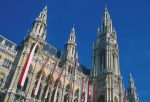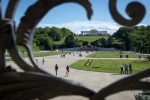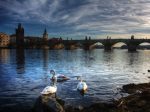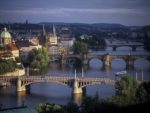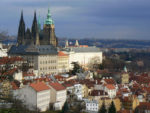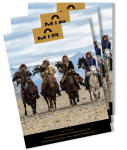Eastern Europe Discovery
Budapest to Vienna aboard the Golden Eagle Danube Express
Overview
On this 12-day private rail journey aboard Golden Eagle’s Danube Express you’ll explore the history, culture, and architecture of several of the nations that make up Eastern Europe. Starting in the Hungarian capital of Budapest, wind your way north through Slovakia to Krakow in Poland, home to a stunning Old Town. Continue by rail to Warsaw and Gdansk, stopping off along the way at the UNESCO-listed castle at Malbork. Then turn southwest towards Berlin and Dresden, exploring both cities as you go. The final leg of this journey takes you through the Czech Republic and Austria, with visits in beautiful Prague and alpine Salzburg before the tour concludes in Vienna.
Travels to: Hungary, Slovakia, Poland, Germany, Czech Republic, Austria
Photos and details: Discover what life is like aboard the Golden Eagle Danube Express.
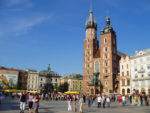
Map
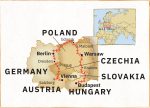
Itinerary
-
Days 1-3: Budapest (Hungary)

Arrive in UNESCO-listed Budapest, built in the grand style of the Habsburgs. Visit the Royal Palace, the largest baroque palace in Hungary used by Franz Josef of Austria, and Matthias Church, originally built in 1255. Enjoy panoramic views of the city from Gellert Hill, and admire the facade of Budapest’s magnificent neo-Renaissance Opera House, decorated with statues of some of the world’s greatest composers. On Day 3, enjoy a reception at the Royal Waiting Room in Budapest’s Nyugati Station before boarding the Golden Eagle Danube Express private train in the afternoon.
HIGHLIGHT
- Budapest, capital of Hungary, with fine baroque, neoclassical, and art nouveau buildings
- The Royal Palace, painstakingly restored and reopened as a museum, its main wing furnished to period standards
- Matthias Church, where King Matthias Corvinus had both of his royal weddings
- The facade of the Budapest Opera House, which at one time hosted Franz Liszt and Gustav Mahler
- The elegant reception at the Royal Waiting Room in Budapest’s Nyugati Station
-
Day 4: Krakow (Poland)

Arrive in Krakow, Poland’s royal capital from the 11th to the 16th century. Wander the largest remaining medieval town square in Europe, Rynek Glowny, the Main Market Square, laid out in 1257. Explore Wawel Castle, the seat of Polish kings for hundreds of years. Pay your respects at Auschwitz-Birkenau, the concentration camp where over 1.1 million people, primarily Jews, were systematically murdered by the Third Reich.
HIGHLIGHTS
- UNESCO-listed Krakow, Poland’s royal capital from the 11th to the 17th century
- Pay your respects and learn about the 20th century’s greatest tragedy at UNESCO-listed Auschwitz-Birkenau, a ghastly reminder of the atrocities committed during WWII
-
Day 5: Warsaw

This morning arrive in the Polish capital of Warsaw where you can learn about the extraordinary transformation of a place almost destroyed by war. Take a walking tour of the reconstructed Old Town, passing the powerful Royal Castle, home of Poland’s kings from the 16th century up to the country’s partition. Visit the elegant Lazienki Royal Gardens and enjoy an outdoor concert of Chopin’s music.
HIGHLIGHTS
- Poland’s capital, Warsaw, with its UNESCO-listed Old Town and Market Square, rebuilt from the ground up after WWII
- Lazienki Park along the banks of the Vistula River, landscaped in 1764 as part of the king’s residence
-
Day 6: Malbork, Gdansk

Explore Malbork’s UNESCO-listed castle, which was the seat of the Teutonic State from 1280. Then continue on to nearby Gdansk. The coastal region of Poland has an important place in Polish consciousness as a key location at the start of World War Two in September 1939. This is where the famous Solidarity independent trade union movement started in 1980 for the protection of worker’s rights, which later became a symbol of resistance against the government and instrumental in the fall of communism.
HIGHLIGHTS
- UNESCO-listed Castle of Malbork
- The remarkable European Solidarity Centre , which presents the 20th-century history of the political changes leading to the collapse of communism and the Soviet Union.
-
Days 7-8: Berlin, Dresden (Germany)

Berlin is one of Europe’s most glamorous capital cities, with superb museums, fine churches, wide boulevards, and a thriving cultural life. Explore the highlights of East and West Berlin by either bicycle or bus. Continue to Dresden the next day. There, visit Wackerbarth Castle, nestled in the delightful landscapes of the Elbe Valley, famous for its for elegant wines which represent the 800-year-old tradition of winegrowing in Saxony. Tour the vineyard and sample some of the local wines.
HIGHLIGHTS
- The Reichstag, the famous Renaissance style building that houses Germany’s parliament.
- The East Side Gallery at the Berlin Wall
- Wackerbarth Castle, a boutique winery with tours, tastings, and a restaurant
-
Day 9: Prague (Czech Republic)

Called the “Hundred-Spired City,” Prague’s beautifully preserved Gothic, Baroque, and Neoclassical churches and palaces make it one of the great cities of Europe. Explore the UNESCO-listed city including Prague Castle, which began in the 9th century as a walled hill-fort; and the Charles Bridge, with its 30 Baroque statues. Learn about the rich Jewish heritage of Prague with a walking tour of the Jewish Quarter. Take a relaxing cruise up the Vltava River by private boat with cocktails on board after lunch.
HIGHLIGHTS
- Prague, capital of the Czech Republic, called the “Hundred-Spired City”
- Old Town Prague, with its 12th-century Town Hall, 14th-century Charles (Karel) Bridge graced with 30 baroque statues, and the 15th-century astronomical clock complete with astrological signs and two of the 12 apostles appearing on the hour
- Prague’s old Jewish Quarter, with its seven synagogues – remnants of the old Jewish settlement
- Prague Castle, which includes St. Vitus Cathedral and the beautifully decorated St. Wenceslaus Chapel
-
Day 10: Salzburg (Austria)

Explore the heart of Salzburg starting at Mirabell Palace. Listed as a UNESCO World Heritage Site, the baroque 17th-century palace is one of the most stunning landmarks in the city. On Market Square (Marketplatz) you will see the former Mozart Residence, now a museum. Cross the Makartsteg bridge into the Old Town and walk along the Getreidegasse, Salzburg’s most famous street which is renowned for its wrought-iron trade signs and the birthplace of Mozart.
HIGHLIGHTS
- Mirabell Palace – a UNESCO World Heritage Site built in 1606 and remodeled in the 18th century as a magnificent baroque palace
- Getreidegasse – Salzburg’s most famous street
- Hellbrunn Palace – a baroque palace situated at the foot of Hellbrunn Mountain
-
Days 11-12: Vienna

Today is a spectacular day with alpine views along the Semmering Railway. Stop in the afternoon of the eleventh day in Austria’s stunning capital, Vienna. Explore the Naschmarkt with its food and antique stalls, and then visit the beautiful Schönbrunn Palace. A concert of classical music rounds out the evening at the Mozart House featuring the Vienna Supreme Orchestra.
HIGHLIGHTS
- The Naschmarkt, Schönbrunn Palace, and a concert of classical music in Vienna
- The Semmering Railway through the Austrian Alps
Dates & Prices
Minimum group size: Minimums vary – call for confirmation status
Land Tour Price, Per Person.
-
2025 Dates
Aug 18 - 29Special guest accompaniment onboard by renowned military historian, broadcaster, and celebrated author Major Gordon Corrigan MBE. Ask about a complimentary post-tour night stay in Vienna as well!Deluxe Class, double occupancy$19,395Deluxe Class, single occupancy$28,975Superior Deluxe Class, double occupancy$24,895Superior Deluxe Class, single occupancy$41,595
-
2026 Dates
Aug 19 - 30Deluxe Class, double occupancy$19,900Deluxe Class, single occupancy$29,700Superior Deluxe Class, double occupancy$25,600Superior Deluxe Class, single occupancy$42,900
What's Included
-
Tour Includes
- Accommodation aboard the Golden Eagle Danube Express private train.
- Hotel accommodation per the itinerary (2 nights in Budapest and 1 night in Vienna).
- All meals starting with dinner on Day 1 until breakfast on final tour day.
- A generous allowance of wine or local beer, soft drinks, and water with all lunches and dinners.
- Complimentary tea, coffee, and mineral water around the clock from your car attendant while on board the train.
- Complimentary draft beer in the Bar Car for all passengers.
- Arrival/departure transfers, provided you arrive and depart on the tour start/end dates and in the tour start/end cities.
- All guided off-train tours per itinerary.
- The services of an experienced Train Tour Manager, with local guides for scheduled off-train touring.
- All gratuities.
- Baggage handling.
-
Not Included
- International airfare or surface transport to the starting/ending cities of the tour. MIR is able to arrange your air itinerary. If you wish to obtain an air quote, please contact us for details.
- Items of a purely personal nature (laundry, telephone, bar account, photography at museums, etc.)
- Optional pre- or post-tour extensions.
- Drinks, beyond draft beer in the Bar Car, and beer and wine at set meals.
- Visa fees, any excess baggage charges, airport departure taxes, vaccination or medical costs.
- Travel and trip cancellation insurance.
Activity Level
-
Level 2: Moderate
Level 2: Moderate
This rail journey by private train features significant touring on foot, throughout which travelers are expected to keep up with other group members, and will feature cold weather and icy and/or wet walking surfaces. Walking during touring days will be on a variety of base surfaces, with many streets and sidewalks being uneven. Elevators are generally not available during touring excursions, leading to some stair climbing. Challenges on board the train include long onboard distances with heavy doors as well as steep steps and gaps to navigate while embarking and disembarking. Only those willing to accept local standards of amenities and services should consider joining this program.
Travelers must be able to walk a mile per day keeping up with other group members. Streets and sidewalks can be uneven or unexpected surfaces, and handrails are not always present. Steps, which may be required due to lack of elevators, may be steep and/or uneven, and may also lack handrails. The weather will be cold and likely wet and icy when off the train. The distance on board the train between sleeping and dining carriages may be significant, and there are many heavy doors to navigate when moving throughout the train. Getting on and off the train involves navigating steep steps, low platforms, and possible gaps between the train and the platform. Navigating rail stations may also involve traveling up and over steep steps/footbridges to cross tracks, or steep steps and dark tunnels to cross under to/from the train station. Although porterage is provided where possible, you may have to carry your baggage for short distances.
General shortcomings of the tourism infrastructure may include problems with bureaucratic service, and availability and quality of public restrooms when not on board the train.




